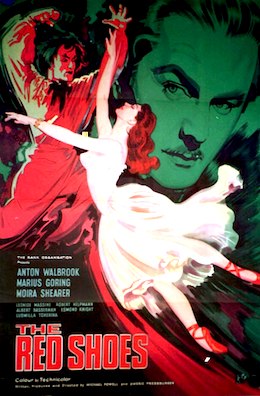
The Red Shoes is a 1948 British drama film written, produced and directed by Michael Powell and Emeric Pressburger. It follows Victoria Page, an aspiring ballerina who joins the world-renowned Ballet Lermontov, owned and operated by Boris Lermontov, who tests her dedication to the ballet by making her choose between her career and her romance with composer Julian Craster.

Michael Latham Powell was an English filmmaker, celebrated for his partnership with Emeric Pressburger. Through their production company The Archers, they together wrote, produced and directed a series of classic British films, notably The Life and Death of Colonel Blimp (1943), A Canterbury Tale (1944), I Know Where I'm Going! (1945), A Matter of Life and Death, Black Narcissus (1947), The Red Shoes (1948) and The Tales of Hoffmann (1951).
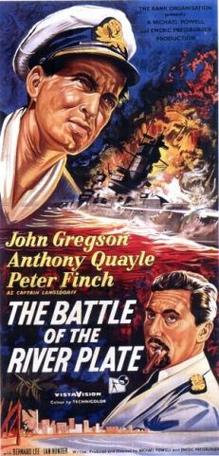
The Battle of the River Plate is a 1956 British war film in Technicolor and VistaVision by the writer-director-producer team of Michael Powell and Emeric Pressburger. The film stars John Gregson, Anthony Quayle, Bernard Lee and Peter Finch. It was distributed worldwide by Rank Film Distributors Ltd.

Emeric Pressburger was a Hungarian-British screenwriter, film director, and producer. He is best known for his series of film collaborations with Michael Powell, in a collaboration partnership known as the Archers, and produced a series of films, including 49th Parallel, The Life and Death of Colonel Blimp (1943), A Matter of Life and Death, Black Narcissus (1947), The Red Shoes (1948), and The Tales of Hoffmann (1951).

A Matter of Life and Death is a 1946 British fantasy-romance film set in England during World War II.
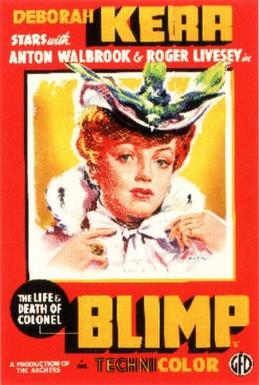
The Life and Death of Colonel Blimp is a 1943 British romantic-war film written, produced and directed by the British film-making team of Michael Powell and Emeric Pressburger. It stars Roger Livesey, Deborah Kerr and Anton Walbrook. The title derives from the satirical Colonel Blimp comic strip by David Low, but the story is original. Although the film is strongly pro-British, it is a satire on the British Army, especially its leadership. It suggests that Britain faced the option of following traditional notions of honourable warfare or to "fight dirty" in the face of such an evil enemy as Nazi Germany.

The British film-making partnership of Michael Powell (1905–1990) and Emeric Pressburger (1902–1988)—together often known as The Archers, the name of their production company—made a series of influential films in the 1940s and 1950s. Their collaborations—24 films between 1939 and 1972—were mainly derived from original stories by Pressburger with the script written by both Pressburger and Powell. Powell did most of the directing while Pressburger did most of the work of the producer and also assisted with the editing, especially the way the music was used. Unusually, the pair shared a writer-director-producer credit for most of their films. The best-known of these are The Life and Death of Colonel Blimp (1943), A Canterbury Tale (1944), I Know Where I'm Going! (1945), A Matter of Life and Death (1946), Black Narcissus (1947), The Red Shoes (1948), and The Tales of Hoffmann (1951).
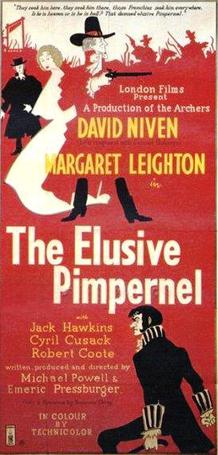
The Elusive Pimpernel is a 1950 British period adventure film by the British-based director-writer team of Michael Powell and Emeric Pressburger, based on the novel The Scarlet Pimpernel (1905) by Baroness Emmuska Orczy. It was released in the United States under the title The Fighting Pimpernel. The picture stars David Niven as Sir Percy Blakeney, Margaret Leighton as Marguerite Blakeney and features Jack Hawkins, Cyril Cusack and Robert Coote. Originally intended to be a musical, the film was re-worked as a light-hearted drama.

Gone to Earth is a 1950 British Technicolor film created by the director-writer team of Michael Powell and Emeric Pressburger. It stars Jennifer Jones, David Farrar, Cyril Cusack and Esmond Knight. The film was significantly changed for the American market by David O. Selznick and retitled The Wild Heart in 1952.
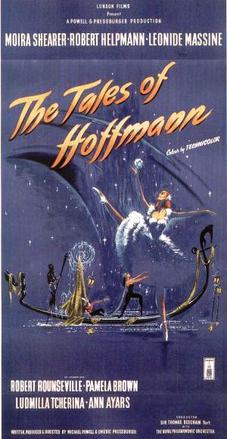
The Tales of Hoffmann is a 1951 British Technicolor comic opera film written, produced and directed by the team of Michael Powell and Emeric Pressburger working under the umbrella of their production company The Archers. It is an adaptation of Jacques Offenbach's 1881 opera The Tales of Hoffmann, itself based on three short stories by E. T. A. Hoffmann.

Ill Met by Moonlight (1957), released in the US as Night Ambush, is a film by the British writer-director-producer team of Michael Powell and Emeric Pressburger, and the last movie they made together through their production company "The Archers". The film, which stars Dirk Bogarde and features Marius Goring, David Oxley, and Cyril Cusack, is based on the 1950 book Ill Met by Moonlight: The Abduction of General Kreipe by W. Stanley Moss, which is an account of events during the author's service on Crete during World War II as an agent of the Special Operations Executive (SOE). The title is a quotation from Shakespeare's A Midsummer Night's Dream, and the book features the young agents' capture and evacuation of the German general Heinrich Kreipe.

Harold Thomas Gregson, known professionally as John Gregson, was an English actor of stage, television and film, with 40 credited film roles. He was best known for his crime drama and comedy roles.
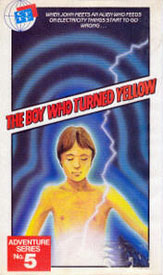
The Boy Who Turned Yellow (1972) is the last film collaboration by the British filmmakers Michael Powell and Emeric Pressburger, and the last theatrical feature to be written by Emeric Pressburger or directed by Michael Powell. The film was made for the Children's Film Foundation.

Belinda Lee was an English actress.
Brian Easdale was a British composer of operatic, orchestral, choral and film music, best known for his ballet film score The Red Shoes of 1948.
Julian Charles Becket Amyes, known as Julian Amyes, was a British film and television director and producer.
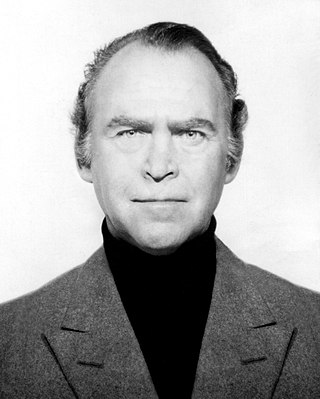
Charles Orme was a British film producer. He worked regularly with Powell & Pressburger, Ralph Thomas, Basil Dearden and John Boorman. He has over 50 credits on a number of classics including The 39 Steps (1959), Khartoum (1966), Deliverance (1972), The Man with the Golden Gun (1974) and The Omen (1976). He was an original member of the multiple-award-winning Powell & Pressburger production team known as The Archers. He was a production assistant, production manager and assistant director on many of their classic productions, including The Red Shoes (1948), The Small Back Room (1949), Gone to Earth (1950) and The Elusive Pimpernel (1950), The Tales of Hoffmann (1951), Oh... Rosalinda!! (1955), The Battle of the River Plate (1956) and Ill Met by Moonlight (1957).
MS Africa Shell, was a British coastal oil tanker operated by the Shell Company of East Africa Ltd. The ship's life was short, lasting only a matter of months from her introduction into service in 1939, until she was intercepted and sunk by the German pocket battleship Admiral Graf Spee in the Mozambique Channel, off the coast of Portuguese East Africa, becoming the sixth victim of Graf Spee's commerce raiding sortie.
Patrick G. G. (Paddy) Dove (1896–1957) was a British merchant navy officer who served as commanding officer of the MV Africa Shell when she was intercepted and sunk by the German pocket battleship Admiral Graf Spee in the Mozambique Channel, off the coast of Portuguese East Africa, becoming the sixth victim of Graf Spee's commerce raiding sortie.
John Julian Somers, known as Julian Somers, was a prolific English stage and screen actor.















